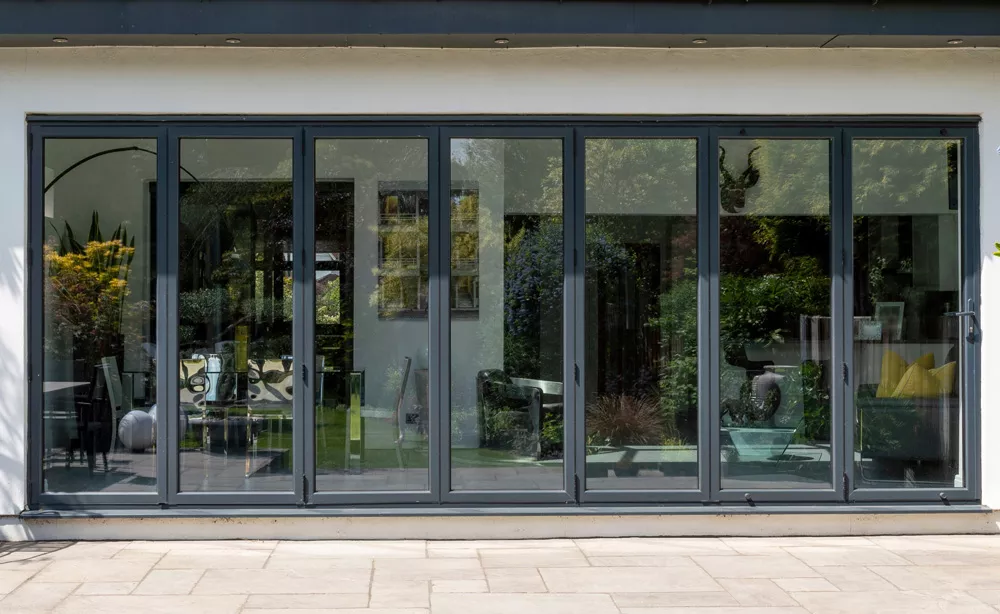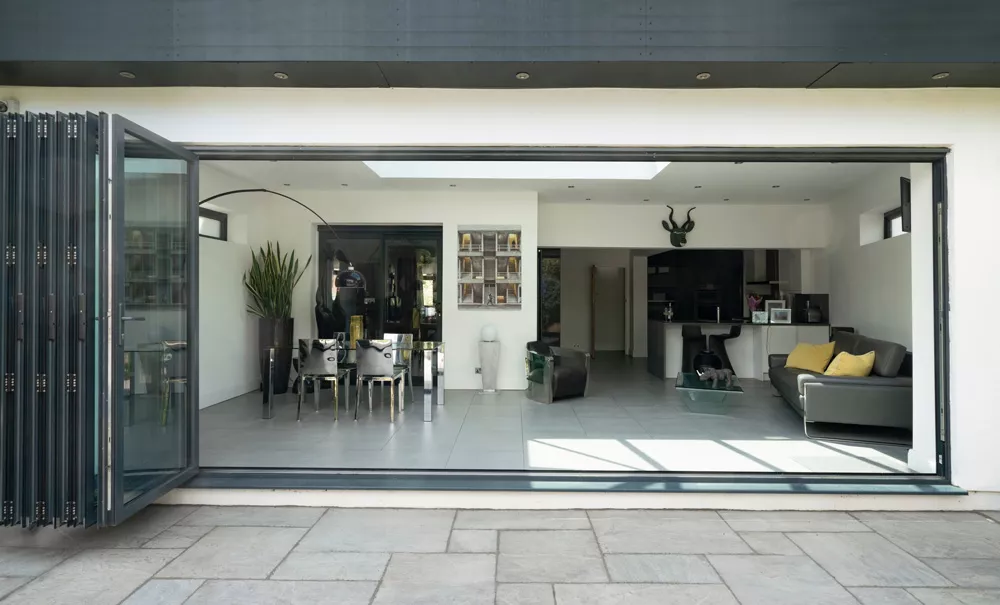Blog
A Guide To Bifold Doors
How do bifold doors work?
Bifold doors are a type of door system that consists of several door panels which fold against each other when opened. They are used as external doors to patios and gardens. Here’s how a common bifold system works:
PANELS AND HINGES
Bifold doors are made up of 3 or more panels. These panels are connected by hinges. The hinges allow the panels to fold in on themselves, which is where the term “bifold” comes from.

TRACK SYSTEM
The panels are typically hung from a track system installed at the top of the door frame. This track guides the movement of the doors as they open and close. Some bifold doors may also have a track or a guide at the bottom. When you pull on the handle or edge of the bifold door, the first panel begins to move along the track. As it moves, it pulls the second panel along with it due to the hinges connecting them. This continues with each subsequent panel until the doors are fully folded and open. When closing the door, the reverse happens: pushing the edge or handle causes the panels to unfold and extend across the opening.

GUIDES & ROLLERS
GUIDES & ROLLERS are crucial components that facilitate the folding and unfolding action of the doors. They are essentially the points at which the doors pivot or fold when being opened or closed. Here’s a detailed explanation of how these pivot points work:
Top Guide: This is located in the track system that runs along the top of the door frame. It often consists of a pin or a roller that fits into a bracket or a track in the door frame. This guides the movement of the door and supports its weight.
Location of the Guides & Rollers: In a bifold door system, pivot points do not feature on every door join, they are positioned on every other door which allows the system to concertina. On a 4 door panel bifold system; there are typically two main pivot points. The first is located at the top and bottom of the first panel of the door (the one closest to the door lock), and the second is at the top and bottom of the last panel (the one farthest from the door lock).
Top Guide: This is located in the track system that runs along the top of the door frame. It often consists of a pin or a roller that fits into a bracket or a track in the door frame. This guides the movement of the door and supports its weight.

Bottom Roller Guide: At the bottom, the guide is usually a similar mechanism that fits into a bracket or a socket on the floor or the lower door frame. This pivot provides additional support and stability, ensuring that the door stays aligned.
- Functioning of Guides: When you open a bi-fold door, the top and bottom guides allow the panels on either side to swing out from the door frame. As the panels move, it pulls the other panels along due to the hinged connections between them. The guides and rollers ensure that this movement is smooth and controlled, allowing the panels to fold neatly as they open.
- Pivot Hardware: The actual hardware used for the pivots can vary. Some bifold doors use a roller system at the top pivot point for smoother operation, while others may use a simpler pin-and-bracket design
Pivot points are essential in the design of bifold doors as they support the weight of the door, guide its movement, and ensure that it folds correctly. They are a key reason why bifold doors are a space-efficient and functional choice for many applications.
Are Bifold Doors Secure?
Bifold door locks designed for external bifold doors will have a locking mechanism that ensures both security and ease of use. Here’s an overview of the most common locking mechanisms and handles for bifold doors:
Lever Handles and Cylinders: Bifold door locks might include lever handles that allow the doors to be secured from the inside without a key. For external doors, a key cylinder is often present for locking and unlocking the door from the outside.
Bifold Hinge Pull Handles: Located in between the panels that don’t have top and bottom guides; the hinge pull handle allows you to pull on the door panels that are away from the door frame back into a closed position. As you pull, all the doors in the bifold door system will move back into the closed position on the door frame.
Bifold Multi-Point Locking System: Many bifold doors, especially external ones, utilise a multi-point locking system. This means that when the lock is engaged, it secures the door at several points along its height. This is more secure than a single-point lock because it distributes the locking action along the edge of the door, making it harder to force open.
Flush Bolts and Drop Bolts: In addition to the main locking mechanism, bifold doors might also have flush bolts or drop bolts. These are usually found on the top and bottom of the secondary door (the one that doesn’t have the main handle or lock) and are used to secure the door in place when closed. They are operated manually and are often used to keep the doors fixed in an open or closed position.
When choosing replacement parts for an installed bifold door, as a starting point we recommend opening the door and checking on the inside of the door profile (where you find the hinges) often you’ll see stamped on the door profile the Manufacturer and model number of the bifold system installed. This information can help you identify the correct replacement parts that you need.
The specific design and operation can vary depending on the manufacturer and the type of bifold door. However, the overarching principle of operation is the same for all.

How to adjust bifold doors?
Many bifold door pivot points are adjustable. This allows for fine-tuning of the door alignment, which is important for proper operation. Over time, doors may sag or become misaligned due to use or environmental factors, and being able to adjust the guides and rollers helps maintain smooth operation.
Lubricate the Track and Rollers: After adjustment, it’s a good idea to lubricate the track and rollers with a silicone-based lubricant for smoother operation.
Adjust the height on the top and bottom roller guides:a) Look for a screw or bolt on the top guide. This is typically the adjustment point.b) Using a screwdriver or an appropriate tool, turn the adjustment screw. Turning it one way will raise the door, and turning it the other way will lower it. The direction can vary depending on the door model, so if you’re not sure, try a small adjustment first to see which way it goes.c) Make small adjustments and check the door alignment and operation after each adjustment. The goal is to have the door parallel to the frame with a consistent gap along the edge.
Check the Door Operation: Open and close the door several times to check for smooth operation. Ensure there’s no scraping against the floor or the frame. The door should fold and unfold easily without resistance.
Check the Locking mechanism: Is the locking mechanism still functioning as it should, does the keep line up correctly with the locking points?
Explore the Extensive Collection of Bifold Hardware at TSSPRO
TSSPRO is excited to announce the expansion of our range of bifold door hardware. Our newly stocked selection encompasses a comprehensive range of bifold locks, bifold handles, bifold hinges, and bifold hinge pull handles. We’ve also included a wide variety of bifold top and bottom roller guides, along with a selection of other accessories.
We take pride in offering products from some of the most renowned and trusted brands in the industry. Our stocked brands for Bifold include ERA, Debar, Caldwell, Clearspan, FSD, and many more.
This blog is intended as a guide to the operation of the products in it. Whilst we may describe standards and scenarios, we cannot recommend the use of these products for a specific environment or circumstance. The specification of any product must be undertaken by the professional on-site who has knowledge of the building, its inhabitants, its intended use, and any other requirements. We cannot say that a product is suitable for a specific use case.








